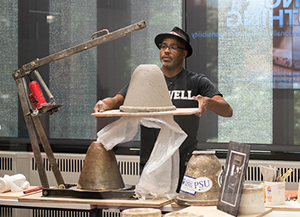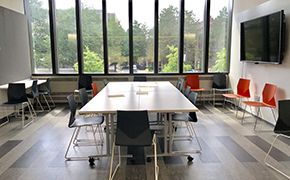Instructor Insights pages are part of the OCW Educator initiative, which seeks to enhance the value of OCW for educators.

Professor Carpenter demonstrating how to construct a ceramic water filter. (Image by Sham Sthankiya Photography. Used with permission.)
Below, Professor Lawrence Susskind responds to questions about his experience facilitating the “Intentional Public Disruptions: Art, Responsibility, and Pedagogy” residency, along with Professor Stephen Carpenter, Ida Ely Rubin Artist in Residence.
OCW: Who participated in the Fall 2017 residency? What kind of background experiences related to the residency did participants bring to the experience?
Lawrence Susskind: The most important participant was our leader, Professor Stephen Carpenter. He guided us through a careful exploration of the roles and responsibilities of the artist in an urban environment, building on his own personal experience. Graduate and undergraduate students from various parts of the Institute, especially the Department of Urban Studies and Planning (DUSP), participated along with a half dozen DUSP faculty. We opened several of the events to the broader MIT and Cambridge/Boston community seeking the involvement of art educators and community organizers. At each of the nine events spread over four months, we had diverse participation. Some of the participants were artists, but most were not. They came to hear Professor Carpenter talk about his idea of disruptive interventions by artists in the public realm seeking to encourage social change of various kinds.
OCW: What inspired you to collaborate with Professor Carpenter to create the residency? And, in your view, why is it important to highlight art and pedagogy in urban studies and planning?
I had met Professor Carpenter two years earlier at a conference at the University of Wisconsin. At that time, he was in his performance art mode — rapping about water, its meaning and its importance to people living in cities and rural areas. He changed the tone and direction of the conference. Scholars who had come to share their scholarly research on various aspects of water management felt obliged to talk about the meaning and importance of their work in terms of everyday life. While some of the time he presents himself as an art educator, other times he appears as a ceramicist who makes very special (entirely inexpensive) pots that allow people to purify water that has been polluted, merely by pouring it through the pot (that has been shaped and glazed in a surprising way). On other occasions, he is a performance artist intruding into public spaces (reading aloud or arranging artifacts in ways that cannot be ignored). He never fails to engage onlookers in ways they never imagined, sometimes about sensitive and difficult topics, such as race relations. In the Department of Urban Studies and Planning we want to teach our students to intervene in cities on behalf of the poor and the disadvantaged. Professor Carpenter does this routinely, using art and public displays, in ways our students need to learn about.
(Professor Carpenter) has found a strategy for engaging people in discussions of race they would normally not know how to pursue.
— Lawrence Susskind
OCW: What does Professor Carpenter mean by public pedagogy?
For Professor Carpenter, public pedagogy means presenting yourself and your art in public spaces in ways that force people to think about issues (like clean water or who has access to that potable water) from different standpoints, and in new ways. He has found a strategy for engaging people in discussions of race they would normally not know how to pursue. His use of photographs on his cell phone (and his very engaging personality) are enough to get strangers to stop, listen, and talk. These are techniques of public engagement that all urban planning students ought to know about, but our faculty doesn’t have the expertise to teach. We are very excited that the OCW supplemental resource captured the nine sessions with Professor Carpenter and will be available for instructors anywhere and everywhere.
OCW: How did Professor Carpenter create space in the residency for having challenging conversations about social inequalities?

Professors Susskind (left) and Carpenter (right) facilitating a residency seminar. (Image courtesy of Sham Sthankiya Photography. Used with permission.)
At one session, Professor Carpenter asked each of us to find a public space on campus and read aloud from a somewhat controversial text in which the race of the character was at the heart of the story. He wanted us to try engaging the people who stopped to listen. Some of us weren’t very good at it. Some were uneasy even reading aloud in a public space. In the discussion after those efforts (and after he modeled how he would do it), the participants in the seminar were able to talk about important but sensitive subjects in a less inhibited way. At another session, he had us all making small clay pots that follow the design he and others have pioneered that makes the pots capable of cleaning polluted water without any electrical or chemical enhancement. He had videos to show how colleagues he has worked with have set up small local factories in Latin America and Africa, enabling local residents to not only make the pots, but also sell them (at very modest prices) to create a viable business. For all the talk of water policy and water management at MIT, I doubt that very many faculty and students have had as much of an impact on as many people in poor areas as Professor Carpenter. He has accomplished all this as an art teacher rather than as a policy analyst. The idea that outsiders can intervene in a helpful way in places they do not know well, and teach residents not just a skill, but a skill that produces something that can immediately improve their lives and lead to a long-term source of income, is startling and inspiring.
› Read More/Read Less
Curriculum Information
Prerequisites
None
Requirements Satisfied
None
Offered
This residency was offered during the Fall 2017 semester and included 9 sessions over the course of 4 months.


 Room 1 of 1
Room 1 of 1 